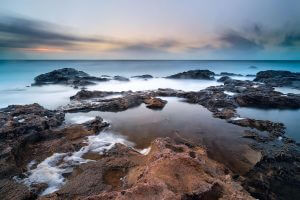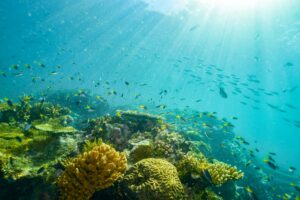Support Hidden Compass
We stand for journalism, science, history, and hope. Make a contribution to Hidden Compass and stand with us.
My brother had been dying for 11 years when we took a field trip to his final resting place.
He dragged me down the dock in Wrangell, Alaska, announcing, “Look, there’s Brenda. She’s the captain you need to find when I finally go. Her boat has flame paintwork. It’s the closest legal thing to a Viking funeral.”
“You know this is kinda creepy, right?” I said.
“I just want you to be prepared,” he replied. “I could die any second now. I didn’t get my pacemaker’s batteries replaced. A hot blonde could walk by and — boom! It would all be over, and I could finally get some rest!”
His laughter bounced over the water, loud as ice calving off a glacier.
“He was thought of as the transformer, the trickster. He was the being that changed things — sometimes quite by accident, sometimes on purpose.”
My best friend and brother-by-choice, the travel writer Edward Readicker-Henderson, never did anything in easy mode. He insisted on living alone, even when Crohn’s disease and its knock-on effects left him unable to stand quickly without passing out. But Ed would build his energy back up, then do something gonzo like hike into the crater of Maui’s Haleakalā volcano.
Doctors first told him to stay put in 1990. “I have been to more than 50 countries since I was told to stop traveling,” he admitted in his 2014 TED talk, titled “Kill Your Bucket List.” “I’ve met kings and shamans, and I’ve fallen in love, and I’ve fallen back in love, and I have been pecked by penguins.”
The road didn’t just rise up to meet him. It gave him a reason to cheat death, over and over and over again.
So when work took us both to Wrangell in 2010, I agreed to visit where his ashes would finally rest: the Stikine, a 335-mile-long wild gorge known to paddlers as the “Everest of whitewater kayaking.” It wells from headwaters sacred to the Tlingit, Haida, and Tsimshian people in British Columbia, marrying ice and raindrops into North America’s fastest free-flowing, navigable river. As it barrels down to the sea in Alaska, its colors shape-shift. Rock sediment — milled fine as flour by the glaciers — scatters light, making the Stikine kaleidoscope from misty gray to emerald and even turquoise. Sometimes the dried silt gets whipped into the air and pierced by sunshine, creating a golden, glowing, ghostly haze.
Ed picked his way along the bank, his tall lanky figure sharp against ice-gilded mountains, more at peace than I had ever seen him. He always got crabby being photographed, but I raised my telephoto lens anyway, knowing that he — and everyone who loved him — needed this moment preserved.
The glass’s glint caught his attention, and then, incredibly, my brother smiled.
He knew I would carry him back where he belonged.
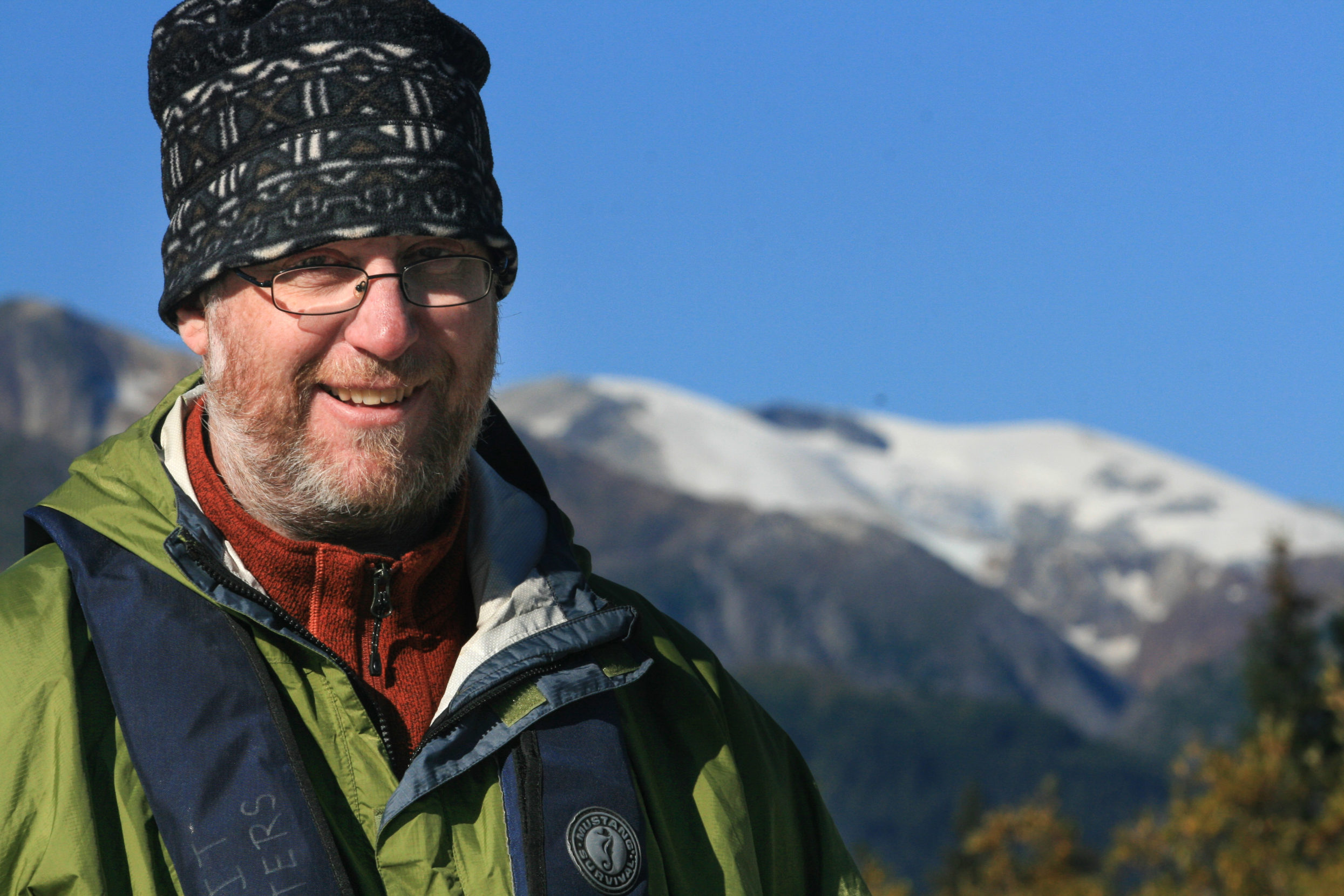
Travel writer Edward Readicker-Henderson on the Stikine River, near Wrangell, Alaska. Photo: Amanda Castleman.
~~
The ferry slipped past sheaves of blue, the ocean fading into otter-hump islands, then mountains thick as shark teeth. The summertime night sky never grew ink-dark as we neared southeastern Alaska. I’d tried to shield my eyes from the solarium’s heat lamps, as I camped on deck, sleeping on a cheap plastic chaise lounge. But the filaments blazed scarlet as we travelers slowly rotated in our sleeping bags, grilling like snacks at a convenience store.
Periodically I’d drift awake to watch our progression up the Inside Passage, the slow dance of sea, mist, forest groves, and glacier-scoured stone. Tears often fogged my view. My brother had died a year earlier, in June 2016. A handcrafted paper urn contained his ashes, and both would soon dissolve into the Stikine.
I was determined to bring him all the way home by water, the route to Alaska he loved best. So I’d booked a two-night passage on the ferry running from Bellingham, Washington, where he lived, to the Panhandle, where he came of age and returned again and again.
“The landscape just makes sense to me there,” he often said. “I need mountains with their peaks lost in the clouds, a lid on the world.”
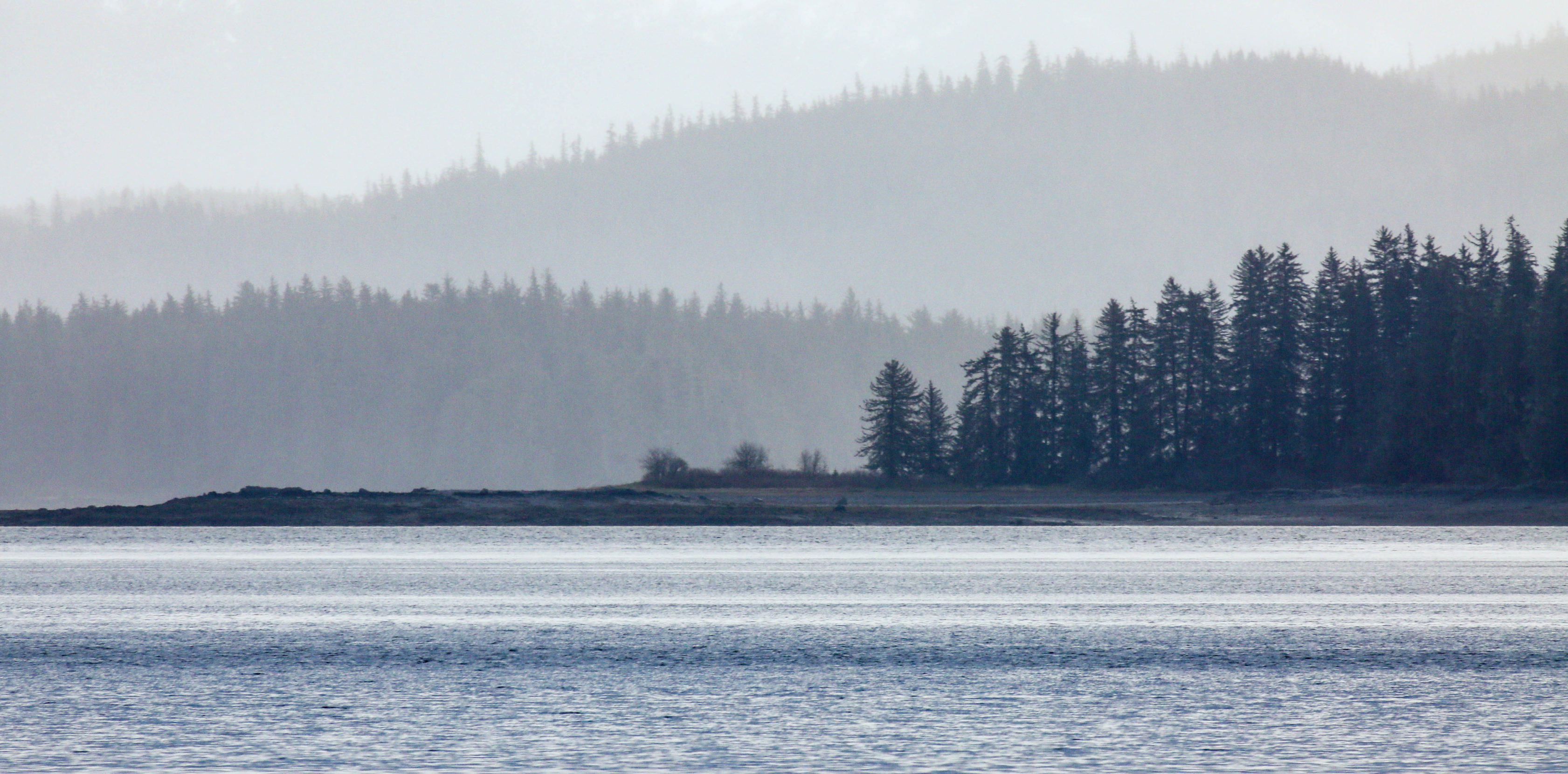
Alaska’s Inside Passage. Photo: Amanda Castleman.
Northern latitudes always signaled home to him more clearly than any channel buoy. As he wrote in AFAR magazine, “I’ve woken to the hissing of rivers, to bears whacking my cabin walls, to the gunshot clap of glaciers melting, to the 3 a.m. howl of lonely wolves, and even to my little sister screaming, ‘Mosquitoes are biting my plumber’s crack!’”
(That last bit is my enduring contribution to Alaskan literature, by the way. You’re welcome.)
Ed may have been the closest thing to a holy hermit the Land of the Midnight Sun has seen in generations. But now, he’s in a paper urn in my backpack, creating unease from the other campers about having cremains on deck. I shrugged off their side-eyes and pitying looks — all the horrible awkwardness surrounding death. I was grieving, adrift in memory. Almost untouchable.
Until I startled awake, aware of a body invading my space.
“We need to go full Viking,” Ed’s beloved cousin Patti Kloehn announced, her gray curls hovering overhead. “Let’s set the urn on fire.”
I shoved the bandana off my eyes and scowled. “NOT a pre-coffee conversation!”
She beamed. Patti bosses around network TV people for a living and is an unstoppable force of nature. She knows when it’s all over but the crying.
~~
You’d think we would have all been better prepared. Doctors told Ed he had a year left, but when that happened six times over 17 years, everyone got a bit complacent.
Three terminal illnesses peaked at the same time, though, and ended his miracle run when he was just 53. I had a ringside seat, as his medical and financial power of attorney. He didn’t want to burden his elderly Arizonan parents with caregiving or charging around the Alaskan bush with his ashes.
“Why you?” his mother asked me, her voice tight with pain, as we grabbed lunch between shifts by Ed’s side at the hospital. “He has real sisters.”
I bit down on my knee-jerk response: You mean the sisters who aren’t here?
Instead I gathered all the compassion my exhausted, heartbroken brain could muster. “I know it’s weird,” I said. “It’s weird for me too. But I knew him best for these last 11 years.”
~~
When I was a little girl, an only child, I begged for a sibling. My dad created a fictional one for me named Edward: a brilliant, irreverent, mercurial character.
Imagine my surprise when I actually met him, on a work trip to Jordan, when I was 30. A middle-aged man with a calico beard dashed up and complimented my website (which we eventually determined belonged to the other travel writer Amanda Castleman). Then he insisted on carrying my camera gear, since I had torn muscles along my ribs. I had no idea he often couldn’t walk without a cane when he shouldered that bag.
~~
The road didn’t just rise up to meet him. It gave him a reason to cheat death, over and over and over again.
Two days before Ed’s death, I’d left his side, worried that the flu I’d caught might spread to him and other patients in the Bellingham clinic, 90 miles north of my Seattle home. He called, saying, “You were an amazing little sister. Thank you. I love you.”
“Knock it off with the melodramatic faux-deathbed speech,” I said. “I’ll be up on Thursday, and I’ll bring you the last of the grapefruit gum from Croatia.”
We always loved dark humor and treating each moment as normal, even when it couldn’t possibly be. The docs scolded us for it, over and over. “Stop laughing because he got disoriented and yanked on your face like a Scooby-Doo mask reveal” is an actual thing we were told. Repeatedly.
But our compasses always realigned to true north: laughter and wonder.
Anybody can dazzle in moments where travel distills the dreams of who we all could be, released from the weight of everyday life. Yet I loved my brother more for the blooper reel. For his unyielding belief that only truly macho men — like him — have Winnie-the-Pooh tattoos. And for the time a baseball-cap-obsessed boyfriend cheated on me right before a big research trip to the Balkans. Ed dropped everything, flew to Europe, and graffitied “Death to Hatboy” in permanent marker along the entire route.
I miss watching zombie flicks and kayaking among lily pads and eating wood-fired pizza from his local gas station — all those seemingly meaningless interstitial exchanges you can’t ever recover once a hole has been punched in the foundation of your life.
~~
Ed specified not only the Stikine and Captain Brenda’s boat with hot-rod flames but also the memorial’s soundtrack. “Make sure that Lou Reed is singing ‘What’s Good,’” he instructed. “Beyond that, I want as little fuss as possible. Thank you, everyone. You have been joys and miracles to me.”
It all felt like too much as Cousin Patti and I emptied out his treehouse-like rental, which towered over a Bellingham beaver pond. The end had happened gradually, then suddenly. Exhausted, as faded as Ed’s Tibetan prayer flags, we punted the memorial to a year out. She flew back to Georgia. I napped in front of RuPaul’s Drag Race reruns, hoping the shimmer of sequins would obscure some of my grief.
A year gave everyone time to plan. Too much time, perhaps. The program complexified like a snowflake crystallizing around dust. Maybe none of us could quite believe that Ed had died, after two Damoclean decades. Then abruptly he was gone forever, leaving us alone with his honey jars and 25-cent Mold-A-Rama dinosaurs and other Edwardian keepsakes.
So we clung tight to the last horizon, this madcap expedition into the Alaskan backcountry, until it erupted into the 11-day, 1,600-mile Full-Viking Funeral Plan.
~~
The M.V. Malaspina wended through the Wrangell Narrows, a 22-mile slalom between islets, reefs, and shoals, buffeted by strong tidal currents from each direction, clashing midway through the channel like rutting elk. In one section the red and green navigation lights cluster so densely that locals call it Christmas Tree Lane.
The vessel briefly suctioned onto a bank, before the engines roared into reverse and wrenched it loose. I’ve made this run at least a half dozen times, and it’s never more thrilling than on a ferry that seems too big to weasel through the passage. Sometimes children — campers or maybe homesteaders — sprint alongside the boats, giggling and whooping, almost close enough to high-five.
“The landscape just makes sense to me … I need mountains with their peaks lost in the clouds, a lid on the world.”
The Malaspina docked in Wrangell, spilling us into the tiny town. Dove-gray clouds lowered a wool cap onto the world, just the way Ed liked it. Their weeping filled the steep mountain streams, the muskeg boglands, and the coastal temperate rainforest. In summer and autumn, bears grub salmon out of the rivers here; each one can chuck around 40 carcasses a day onto the banks. As the fish decompose, they nourish the moss-muffled landscape — the Sitka spruce, the hemlocks, the Alaska yellow cedar.
Glossy ravens rustled high in the old-growth trees, sometimes mimicking raindrops, dog barks, and even human voices. Many Alaska Native traditions say these birds created the world and brought it daylight. But according to Haida artist Christian White, “Raven was not thought of as a god … He was thought of as the transformer, the trickster. He was the being that changed things — sometimes quite by accident, sometimes on purpose.”
Ed had that gift too. His candor about his torso, shredded and seamed by surgeries, gave a mastectomy patient the courage to date again. His article on manga led to a quarter century of correspondence with a legendary fantasy-horror author, a best friend he never met in person. His rhapsodies about pilgrimages, the quietest place on Earth, and how he cheated death reminded readers of the world’s infinite grace and beauty. Yet he also nicknamed my slyboots cat “Satan’s Ear Swab,” never shut up about how I made him sleep in a Ljubljana prison (renovated into an art hostel), and snarked his way through stories about a bra fence and strip passport.
My brother penned “Wander Cure for Lust,” a brief essay about our Balkan trip, set in the World Heritage city of Trogir, Croatia. “Amanda and I did the only sensible thing,” he wrote. “At a [cathedral] side altar, we bought foot-long beeswax candles for a single coin. Then, on this island we had not heard of a day before, we threw glowing prayers into the soot-streaked walls. I didn’t ask what hers was about: mine was one of thanks.”
Later he told me that journey saved his life, as he fought the depression that had come with his divorce and his body’s accelerating decline. And I said something little-sister-ish like, “Dude, have some grapefruit gum, and let’s pick an objectionable ’80s movie to watch, so you can drool over the fluffy blondes already.”
Because our sibling superpower was always moving forward, locking our eyes on the horizon, so full of beauty and banter.
~~
Like me, the Stikine has a big mouth. Cousin Patti and her husband, Tom, scavenged on a cobblestone beach near its delta, collecting driftwood for the Full-Viking pyre raft. One bough arched, an echo of a raven’s beak. Eerily, it even had rough eyeholes.
We lashed down the paper urn — the moss green of Ed’s favorite dog-walking raincoat — with jute twine. Then we tucked in letters and shells and pressed flowers sent by friends who couldn’t spare 11 days for our Edwardian mourning ritual.
One had even mailed white rum to sip, then sprinkle — a Caribbean tradition to encourage my brother’s spirit to move on, so that he wouldn’t join the zombie hordes from his favorite B movies.
Cousin Patti eyed the Captain Morgan miniature, then announced, “We’re gonna need lighter fluid too.”
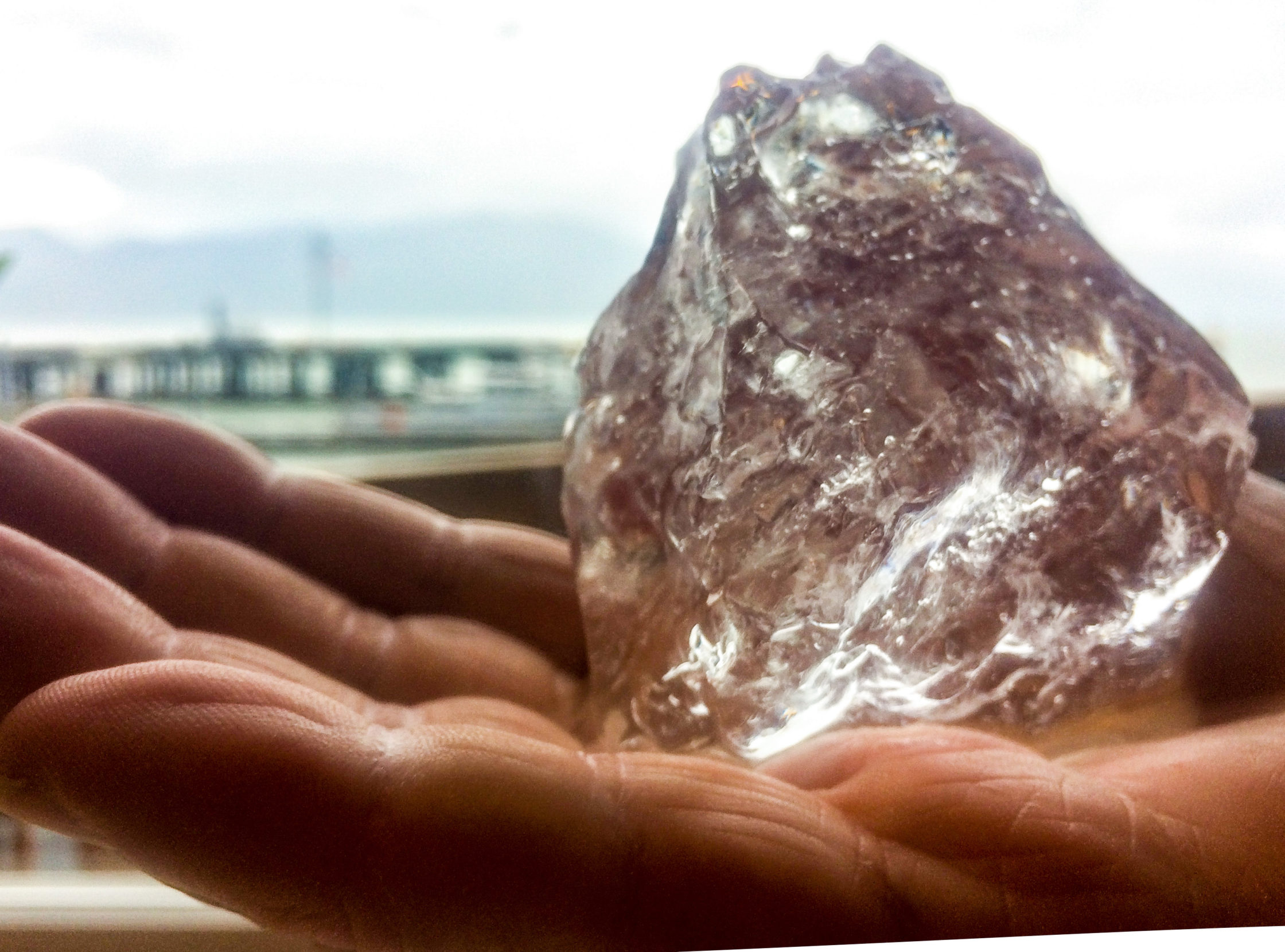
On the 11-day journey of mourning, a chunk of glacier ice from the Le Conte Glacier was crafted into cocktails to toast Readicker-Henderson. Photo: Amanda Castleman.
~~
Ed and I once sailed up Norway’s fjord-frayed coastline on the country’s mail boat. Before flying home to the U.S., we raced to see another ship, the Fram, up on blocks in an Oslo museum. This chonky wooden egg was built to battle through high-Arctic winters that never brighten beyond dishwater gray twilight. Its name means “forward.”
We lingered on its bridge, lacing our legs through the railings. “Imagine three years aboard,” I mused, thinking of that first expedition, beached on an ice slab, blindly following the Transpolar Drift. “You would have memorized every nail head, every harmonic of every line in every wind.”
Ed laughed. “Yeah, you’d do great, judging from a week on the mail boat.”
“No, no,” I insisted. “That’s floating. The Fram is forward.”
He nodded. Because who is more about momentum than the man defying his own death’s gravity?
We bought tin mugs stamped with the vessel’s name, one each and one for our friend’s newborn. Eventually we sent it with this note: “This cup is from the Fram, the ship that has been further north and south than any other ship in history. The word ‘fram’ means ‘go forth,’ and we think that means the entire world is a huge playground, and all you have to do is go out and play, be attentive, and it will reward you endlessly.”
Our friend framed the postcard and hung it as a benediction over her child’s crib. Today that daughter is a strong-limbed dancer who’s getting ready to apply for college.
My mug, Ed’s mug — they hang together on hooks in my kitchen window.
I do not know where he has gone.
~~
Ed believed in the spirit world, believed that pioneer ghosts once square-danced in his Wyoming dining room. I’d nod along when he talked about it, ever the polite agnostic.
After I sorted the last of his possessions — sending art here, books and Turkish rugs there, leaving his truck laden with heirlooms for his family — I had my only dream about my brother ever. It felt so real that I blurted out, “You’re back! Oh, no! I just gave away all your stuff.”
“That’s OK,” he said. “I don’t need it where I am. I just came back to tell you to take better care of yourself.”
I woke up crying and laughing, and turned to my partner, Doug. “That felt so real,” I said. “Could parts of us linger here with loved ones? I don’t know.”
“I do,” he replied. “Because if that had really been Ed, he would have absolutely been gloating that he was right about the existence of ghosts.”
~~
The 11-day, 1,600-mile Full-Viking Funeral took us upriver into the Stikine-LeConte Wilderness, part of the imperiled Tongass National Forest. Our Valkyrie, Captain Brenda, transferred us from her cabin to two of the 80 backcountry huts that Alaska maintains for public use.
As a former wilderness guide, I knew to take the pepper spray and sing to alert bears as I strode to the outhouse or a waterside basking rock. So did a travel writer friend down from Anchorage for the memorial.
Cousin Patti and Tom kept forgetting, though. I lost a lot of sleep as I imagined alerting Ed’s family that other members had died on my watch.
But I couldn’t stay mad for long. Patti alone had joined the honor guard up the Inside Passage. Plus, Ed — who had lived for years in Japan — always treasured a Zen koan about not spiraling out of control.
Two monks encountered a lady unable to cross a raging river. Despite a vow not to touch women, the senior monk carried her across the water. Hours later the younger one erupted, asking how dare he violate sacred precepts like that.
“I put her down long ago,” replied the senior monk. “Why are you still carrying her?”
Whenever either of us needed a reality check, Ed and I would remind each other, Put it down by the river.
And now here we were at the Stikine.
~~
Bundled in fleece and waterproof clothing, our mourning party clustered at the edge of Shakes Lake, named for a line of powerful Tlingit chiefs. Rainforest wrapped around us, more hushed than any cathedral, except for Lou Reed and the glacier occasionally shearing into water green as jade.
His laughter bounced over the water, loud as ice calving off a glacier.
Rum and lighter fluid cut through the scent of snow. And then the Full-Viking raft blazed straight toward a turquoise iceberg shaped like an orca. I laughed through the tears and the rain, because the sight was deep, poetic, and ridiculous — just like Ed.
We had put him in the river, then let him rise up like glowing prayers, smoke dissolving into the mist.
Our little group turned away before the flames guttered.
We wanted to remember Ed as he’d lived: going forward, burning bright, soaring far beyond the lid of the world.
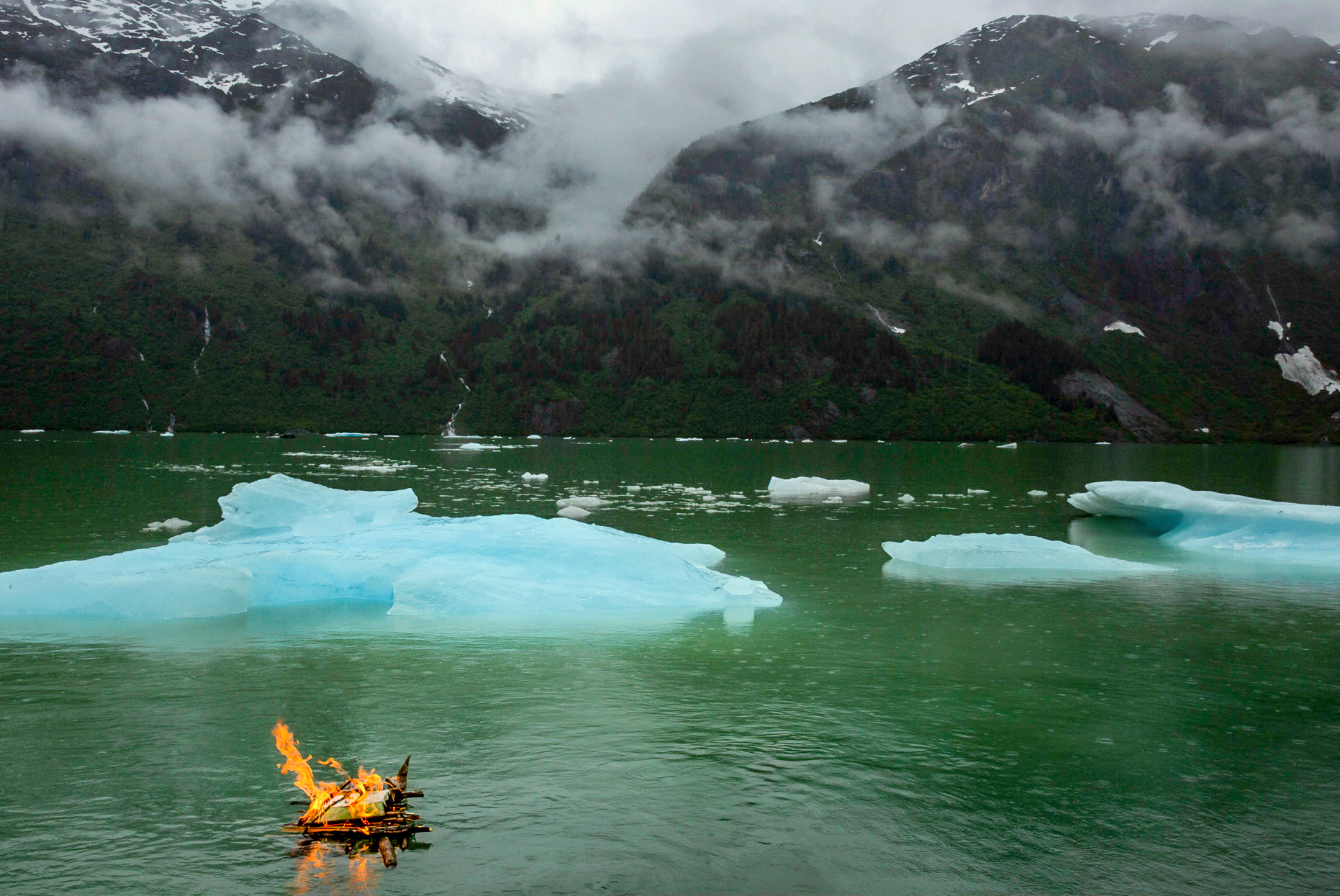
The full Viking memorial for travel writer Readicker-Henderson floats on Shakes Lake, Stikine River. Photo: Amanda Castleman.
Amanda Castleman
Despite her yoga and yogurt tendencies, author Amanda Castleman is a former wilderness guide who remains happiest when grubbing around in nature.

